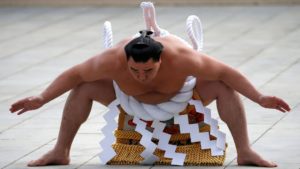(Reading Time: 15 min Approx)
Sumo is said to have started over 2,000 years ago. From around the Heian period (794-1192), the imperial family often watched sumo as a form of entertainment. Sumo evolved over many centuries, with the first professional sumo wrestlers appearing in the Edo period (1603-1868).
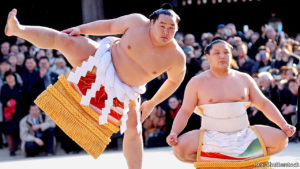
Sumo, style of Japanese wrestling in which weight, size, and strength are of the greatest importance, though speed and suddenness of attack are also useful. The object is to propel the opponent out of a ring about 15 feet (4.6 metres) in diameter or to force him to touch the ground with any part of his body other than the soles of his feet.
 The wrestlers wear only loincloths and grip each other by the belt. In Japan, sumo wrestling was under Imperial patronage between 710 A.D and 1185 A.D and was a popular spectator sport. During this era it was refined from a brutal submission spectacle into a highly ritualized toppling match in which victory could be gained by forcing the opponent out of a 15-foot circle. In addition to its use as a trial of strength in combat, sumo has been associated with Shinto ritual. Some shrines carry out forms of ritual dance where a human is said to wrestle with a kami, a Shinto divine spirit. It was an important ritual at the imperial court, where representatives of each province were ordered to attend the contest at the court and fight.
The wrestlers wear only loincloths and grip each other by the belt. In Japan, sumo wrestling was under Imperial patronage between 710 A.D and 1185 A.D and was a popular spectator sport. During this era it was refined from a brutal submission spectacle into a highly ritualized toppling match in which victory could be gained by forcing the opponent out of a 15-foot circle. In addition to its use as a trial of strength in combat, sumo has been associated with Shinto ritual. Some shrines carry out forms of ritual dance where a human is said to wrestle with a kami, a Shinto divine spirit. It was an important ritual at the imperial court, where representatives of each province were ordered to attend the contest at the court and fight.
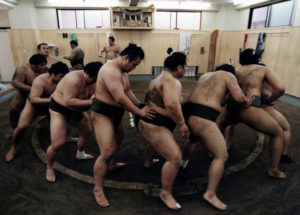
Perhaps the best way to appreciate sumo is to visit a sumo stable to witness a morning practice session. Sumo stables are where the wrestlers live and train together and where all aspects of life, from sleeping and eating to training and free time, are strictly regimented by the stable master. There are about forty stables, all of which are located in the Greater Tokyo Region, especially in Tokyo’s Ryogoku district.
Sumo matches take place in a dohyō (土俵): a ring, 4.55 m (14.9 ft) in diameter and 16.26 sq.m.(1 75.0 sq ft) in area, of rice-straw bales on top of a platform made of clay mixed with sand. A new dohyō is built for each tournament by the bout callers (or yobidashi). At the center are two white lines, the shikiri-sen, behind which the wrestlers position themselves at the start of the bout. A roof resembling that of a Shinto shrine may be suspended over the dohyō. Women are traditionally forbidden from entering or touching the ring.
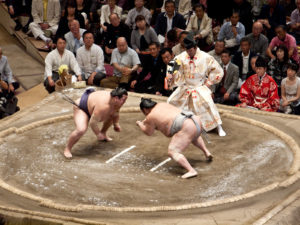 Wrestlers enter sumo in the lowest jonokuchi division and, ability permitting, work their way up to the top division. A broad demarcation in the sumo world can be seen between the wrestlers in the top two divisions known as sekitori (関取) and those in the four lower divisions, known commonly by the more generic term rikishi (力士). The ranks receive different levels of compensation, privileges, and status.
Wrestlers enter sumo in the lowest jonokuchi division and, ability permitting, work their way up to the top division. A broad demarcation in the sumo world can be seen between the wrestlers in the top two divisions known as sekitori (関取) and those in the four lower divisions, known commonly by the more generic term rikishi (力士). The ranks receive different levels of compensation, privileges, and status.
A sumo wrestler leads a highly regimented way of life. The Sumo Association prescribes the behaviour of its wrestlers in some detail. For example, the association prohibits wrestlers from driving cars, although this is partly out of necessity as many wrestlers are too big to fit behind a steering wheel. Breaking the rules can result in fines and/or suspension for both the offending wrestler and his stable master.
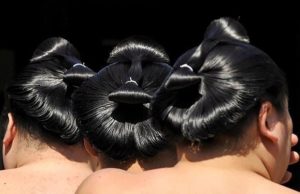
On entering sumo, they are expected to grow their hair long to form a topknot, or chonmage, similar to the samurai hairstyles of the Edo period. Furthermore, they are expected to wear the chonmage and traditional Japanese dress when in public, allowing them to be identified immediately as wrestlers.
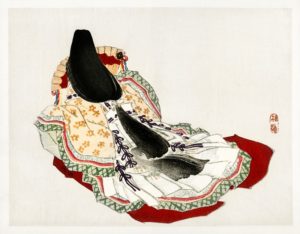 The type and quality of the dress depends on the wrestler’s rank. Rikishi in jonidan and below are allowed to wear only a thin cotton robe called a yukata, even in winter. Furthermore, when outside, they must wear a form of wooden sandal called geta. Wrestlers in the makushita and sandanme divisions can wear a form of traditional short overcoat over their yukata and are allowed to wear straw sandals, called zōri. The higher-ranked sekitori can wear silk robes of their own choice, and the quality of the garb is significantly improved. They also are expected to wear a more elaborate form of topknot called an ōichō (big ginkgo leaf) on formal occasions.
The type and quality of the dress depends on the wrestler’s rank. Rikishi in jonidan and below are allowed to wear only a thin cotton robe called a yukata, even in winter. Furthermore, when outside, they must wear a form of wooden sandal called geta. Wrestlers in the makushita and sandanme divisions can wear a form of traditional short overcoat over their yukata and are allowed to wear straw sandals, called zōri. The higher-ranked sekitori can wear silk robes of their own choice, and the quality of the garb is significantly improved. They also are expected to wear a more elaborate form of topknot called an ōichō (big ginkgo leaf) on formal occasions.
Similar distinctions are made in stable life. The junior wrestlers must get up earliest, around 5 am, for training, whereas the sekitori may start around 7 am. When the sekitori are training, the junior wrestlers may have chores to do, such as assisting in cooking the lunch, cleaning, and preparing the bath, holding a sekitori’s towel, or wiping the sweat from him. The ranking hierarchy is preserved for the order of precedence in bathing after training, and in eating lunch.
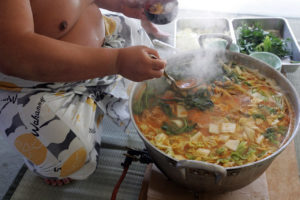
Wrestlers are not normally allowed to eat breakfast and are expected to have a siesta-like nap after a large lunch. The most common type of lunch served is the traditional sumo meal of chanko nabe, which consists of a simmering stew of various fish, meat, and vegetables cooked at the table. It is usually eaten with rice and washed down with beer. This regimen of no breakfast and a large lunch followed by a sleep is intended to help wrestlers put on a lot of weight so as to compete more effectively.
Daily diet of a Sumo-wrestler:
Come lunchtime, sumo wrestlers eat chanko nabe, a stew filled with fish, vegetables, tofu, and meat. Nabe is the standard Japanese stew, but for sumo wrestlers, they need the supersized version or the chanko nabe that comes stuffed with everything that would bulk them up
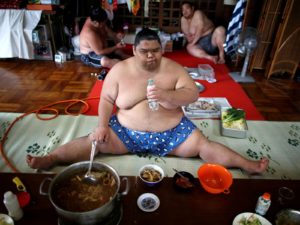
Aside from the humongous meal, sumo wrestlers will complement it with up to 10 bowls of rice and several bottles of beer. Some of the best and healthiest wrestlers can have as much as 6 pints of beer each lunchtime. Some rikishis will dump more noodles into their bowls if they are not yet full and there’s still some soup left.
Their life at stables:
In the afternoon, the junior wrestlers again usually have cleaning or other chores, while their sekitori counterparts may relax, or deal with work issues related to their fan clubs. Younger wrestlers also attend classes, although their education differs from the typical curriculum of their non-sumo peers. In the evening, sekitori may go out with their sponsors, while the junior wrestlers generally stay at home in the stable, unless they are to accompany the stablemaster or a sekitori as his tsukebito (manservant) when he is out. Becoming a tsukebito for a senior member of the stable is a typical duty. A sekitori has a number of tsukebito, depending on the size of the stable or in some cases depending on the size of the sekitori. The junior wrestlers are given the most mundane tasks such as cleaning the stable, running errands, and even washing or massaging the exceptionally large sekitori while only the senior tsukebito accompany the sekitori when he goes out.
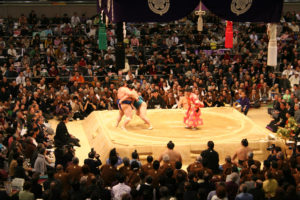
The sekitori are given their own room in the stable, or may live in their own apartments, as do married wrestlers; the junior wrestlers sleep in communal dormitories. Thus, the world of the sumo wrestler is split broadly between the junior wrestlers, who serve, and the sekitori, who are served. Life is especially harsh for recruits, to whom the worst jobs tend to be allocated, and the dropout rate at this stage is high.

The negative health effects of the sumo lifestyle can become apparent later in life. Sumo wrestlers have a life expectancy between 60 and 65, more than 10 years shorter than the average Japanese male, as the diet and sport take a toll on the wrestler’s body. Many develop type 2 diabetes or high blood pressure, and they are prone to heart attacks due to the enormous amount of body mass and fat that they accumulate. The excessive intake of alcohol can lead to liver problems and the stress on their joints due to their excess weight can cause arthritis. Recently, the standards of weight gain are becoming less strict, in an effort to improve the overall health of the wrestlers.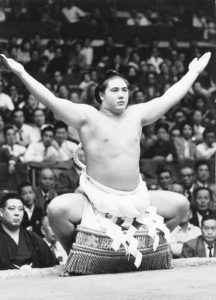
It is more than apparent that life of professional sumo wrestlers is more than eccentric. When it comes to the most famous sumo wrestlers we have to mention Taiho. Tahio is a true legend of Japan who is considered by local people as the greatest professional sumo wrestler of all time since he was able to achieve that rank of yokozuna which is the highest rank in this sport. Taiho also has won forty-five consecutive matches during his career. Another name we have to mention is Chiyonofuji. He was weighing only 120 kg, so he was considered very light on his feet for a sumo wrestler. Other famous sumo wrestlers are Futabayama, Mainoumi, Mitoizumi, and Takamisakari.
Best place to learn:
Most stables in Tokyo are located in the neighbourhood of Ryogoku, a historic district situated between the former Tsukiji Market to the south and Tokyo Skytree to the north. The district is the home of Japan’s national sport Sumo and it’s at the Ryogoku Kokugikan sumo stadium where you can watch the Tokyo sumo tournament.
